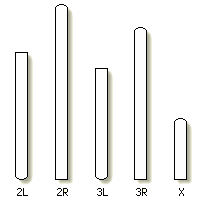Click on a chromosome for a closer view

![]() Ensembl data and displays for Anopheles gambiae are
made possible through a joint effort by the Ensembl group and
VectorBase, a NIAID Bioinformatics Resource Center. Please access
this genome and other resources via the Vectorbase browser.
Ensembl data and displays for Anopheles gambiae are
made possible through a joint effort by the Ensembl group and
VectorBase, a NIAID Bioinformatics Resource Center. Please access
this genome and other resources via the Vectorbase browser.
The genome assembly presented here (AgamP3, February 2006) is a revised assembly based on the whole genome shotgun assembly of the PEST strain of Anopheles gambiae produced by the The International Anopheles Genome Project and described in Holt et al (October 2002) with revisions as described in Sharakhova et al (2007). More details can be found at VectorBase.
Annotation of the AgamP3 assembly was carried out by VectorBase. The set of gene models presented (genebuild 4, released June 2007) combines manual annotation of chromosome arm 2L, data provided by the research community, and gene prediction using the Ensembl system. Prediction utilised alignments of dipteran and other protein sets to the genome and generation of GeneWise models, alignment and gene prediction based on Anopheles ESTs, and selected ab initio predictions. 'Known' genes are those which could be named using entries from the community gene symbol database or from UniProt. More details can be found at VectorBase.
There is no Anopheles gambiae-specific news this release.
Canonical transcripts have been defined for all genes in the core databases.
Read more...
From genebuild 4, VectorBase stable identifiers for genes, transcripts and proteins are used instead of Ensembl-style identifiers. All VB identifiers for Anopheles gambiae begin with the 4 letters AGAP. The same numeric value is used for a gene and all its products. Alternate products of a single gene have suffixes ending A, B, C etc.
Ensembl-style identifiers in the previous genebuild have been mapped where possible to the new identifiers. The web browser page IDHistoryView summarises relationships between old and new identifiers. This page can be reached by clicking the 'ID history' link at the left of each gene view page or from the search results for an unmapped old-style identifier. You can also use HistoryView to enter a list of old-style identifiers and return a list of current equivalents.
Example: Gene CPR34 has the VB identifier AGAP006864, with transcript AGAP006864-RA and protein AGAP006864-PA. The corresponding old identifiers were gene ENSANGG00000020866, transcript ENSANGT00000023320 and protein ENSANGP00000024283.
| Assembly: | AgamP3, Feb 2006 |
| Genebuild: | VectorBase, Jun 2007 |
| Database version: | 50.3k |
| Known protein-coding genes: | 1,316 |
| Novel protein-coding genes: | 11,141 |
| RNA genes: | 488 |
| Gene exons: | 52,595 |
| Gene transcripts: | 13,133 |
| SNPs: | 1,106,441 |
| Base Pairs: | 278,253,050 |
| Golden Path Length: | 273,093,681 |
| Most common InterPro domains: | Top 40 Top 500 |
© 2024 Inserm. Hosted by genouest.org. This product includes software developed by Ensembl.